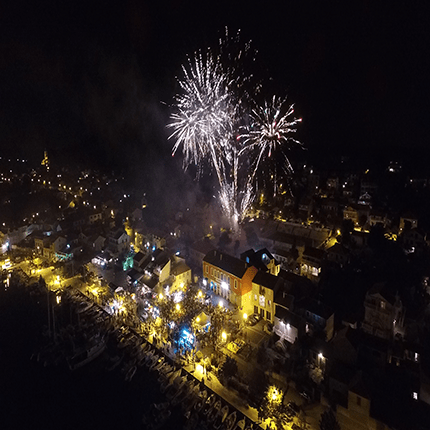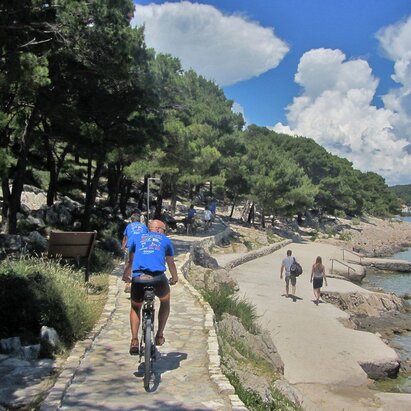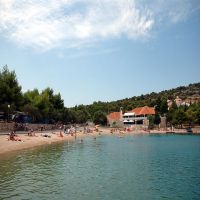Jezera

Jezera's
days
of the Sea

Active
vacation

Virtual
tour
The inhabitants of Jezera traditionally love football and therefore the mini football club MNK Jezera was founded in 1998, one of the most distinguished clubs in the Šibenik – Knin county which participates in numerous tournaments throughout the county and country.
The Sport-Fishing Association «Punta Rata» Jezera was established in 1996 and it has become a significant factor in sport fishing at sea as well an important factor for tourism in the Republic of Croatia. This association offers various information, including information about necessary permits for sport fishing, fishing organized by club members, and information on independent fishing. In the last week of September, this association organizes an international competition called «Big game fishing-Jezera».
The Tradition of old skills is kept by the Association Južnje strane (South side). This association is known for its wooden sailboat regatta Jezerska lantina.
Today an important economic entity in Jezera is «Školjić» D.O.O. where tourism is the most important branch of business, the Tourist resort «Jezera – Village» is a part of the company and the main factor of tourism development of the town and surrounding area with a capacity of 1.500 accommodation units including apartments, rooms for rent and an auto camp. The Croatian Music Union has awarded this tourist resort with a special charter for the quality of the entertainment and music program, and the German tour-operator ADAC has granted them a high acknowledgement for their complete tourist offer.
Jezera has two smaller auto – camps «More» and «Stella Maris», and the inhabitants of Jezera also offer private accommodation in rooms and apartments of high category with a capacity of 1,000 beds.
In 1984, the ACI Marina Jezera was built in Jezera with a capacity of 220 berths, which recieves the eco blue flag every year. ANA – nautical academy and diving school is also located within the Marina. The SAY Hotel is located by the Marina.
Jezera is also an excursion center. Fishing excursion boats set off from Jezera bay towards the nearby islands, Kornati and Krka waterfalls, surrounded by cheer, good fish and wine. It is also possible to rent smaller boats and enjoy in a tour of the small islands and bays.
The small island Kukuljar Vodeni, where there is a small cave by the sea, which has drinking water during ebb tides and salty water during high tides, is particularly interesting. There is a story connected to the small island about the graves of sea robbers from Southern Italy who used to attack, rob and kill the inhabitants of our islands and coast in the past. The inhabitants of the Island Murter used to attack them in organized groups near Kornati killing the pirates and setting fire to their galley. A few bodies had floated to Kukuljar Vodeni, where the fishermen from Jezera buried them, can still be seen by objects that resemble somewhat irregular stone blocks.
Historians assume that this happened during the end of the 16th century.
The first written data about Jezera date back to the year 1298. But, the town is much older. We can find traces of an Illyrian settlement from the 11th century BC on the peninsula Murtarić near the present-day town. Not far from the town, in the bay of Podjasenovac, two graves of the Illyrian tribe Liburna were found in a barrow in the year 1938. There are many similar barrows in the vicinity of the town. There is one large barrow that stands out and looks like a truncated cone and one climbs to its top by following a spiral path. The town inhabitants call it «Pudarica» because pudari, i.e. fielders used to keep the fields there in the old days. However, although it dominates over a large area of vineyards, orchards and olive groves, it is more towards the sea, over the Murtar bay (St. Nicholas). Don Krsto Stošić in his work «Villages of the Šibenik District» (1941) believes that this was built by Illyrians who were there before Croatian inhabitants (Illyrians, Celts) that served as a watchtower over the bay and from this area signs were given to the fleet from which came the names of the hill and bay, an later the island Mor-tar which means sea fort or castle. There were a few similar buildings in the ancient times that were located on the southeast side of the Island of Murter.
Jezera, since the year 1602, has its own parish. In 1722, The Parish of Our Lady of Health was built with beautiful stone plates from the local quarries at the site of the old church. Next to the Church, on the east side, there is a bell tower that is 32m high. Which is also the oldest bell tower on the Island of Murter. The Church has a single nave with one main and two side chapels. There are seven altars and two balconies making it a nice example of Mediterranean Baroque. The main altar contains a bas-relief that stands out of Mary with baby Jesus plated in silver and gold. The altar of Our Lady of Seven Sorrows is particularly interesting and it is also considered to be one of the most beautiful wooden altars in all of Dalmatia.
The Church Saint John of Trogir, in the cove, from the 17th century, houses the local heritage exhibition.
The small Church of Saint Rocco, located in the field, is from the 16th century. The small Church of Saint Constance is located on the hill Kružak and was built in 1780 as a votive church of the patron of malaria, or the high fever that accompanied the disease. For the most part, local residents who were suffering from malaria built this Church. The Church was destroyed in World War II, however in 1994 it was rebuilt with the solidarity of people from Jezera. In the bay of Murter, which is still called Saint Nicholas, stands the Church Saint Nicholas from the 15th century, which was renovated in 2012.
On May 10, 1911 the Society of Jezera seafarers was founded. On the memorial day of the founding and renewal of the Church Saint Nicholas (restored in 2011) decorated boats move towards the bay where a solemn mass is held along with a special program. The majority of files and last testaments, in respect to the town, come from the 15th, 16th and 17th centuries, and they were mainly written in Glagolitic, Bosnian Cyrillic and Latin. In particular, Glagolitic literacy was long developed and carefully cherished which was spoken about in the already mentioned book of Stošić: between 1750-1780, 11 priests died which were all natives of Jezera, as well as the mentioning of another 10 priests and friars from Jezera who served elsewhere. They were all Glagolitic and aided the establishment of the confraternity (brašćina).
Jezera is a settlement with a specific physiognomy. We distinguish the topological characteristics of the three separate parts, which are today linked by modern construction. The youngest part of the settlement, the Sea, stretches along the coast of the bay. Of all the places on the island, Jezera was the first settlement that began building houses, during the mid – 18th century, right by the sea, most of them being summerhouses. By that time, there was already the danger of robbers from southern Italy, so the settlement was built in a compact matter about 400 m from the sea, which was evidenced by two of the older forms of settlements Selo (village) and Košuluk.
They are the owners of a number of islands east and south of the Island of Murter, including part of the Island Kaprije and Žirja as well as a smaller part of the Kornati Islands. They are known, as skilled seafarers/navigators so navigating and fishing are important parts of their economy. Jezera has the most fishermen and seafarers on the Island of Murter.
Since 1682 the inhabitants of Jezera have been hunting on the Kornati and nearby islands. Despite being the smallest village on the island in the 18th century, it boasted the largest fleet of boats. Besides being used for fishing, boats were also used to transport stones from the local quarry mainly to Šibenik and Zadar. The inhabitants of Jezera also engaged in stone masonry. Out of all the fishing cooperatives in this part of the Adriatic, the oldest one is located in Jezera founded on August 9, 1922.
Jezera, the town of seafarers, fishermen and divers is located on the southeast side of the island of Murter. Jezera is secluded into a horseshoe shaped bay that is surrounded by gentle hills. Due to its natural position, the town is not exposed to strong winds and its cove is an ideal port for ships. The town has 960 inhabitants. There are two local beaches and a promenade at the entrance to the bay (port).
The name Jezera comes from the fact that rain is stopped by the impermeable ground, making large puddles. Blato (mud) or Jezero (lake), in ancient times were wetlands that were located southwest of the town, but for the most part they dried up due to malaria in the early 20th century, while the other body of water called Lokva (or puddle) is full of water from the first to the next period of rain.














































